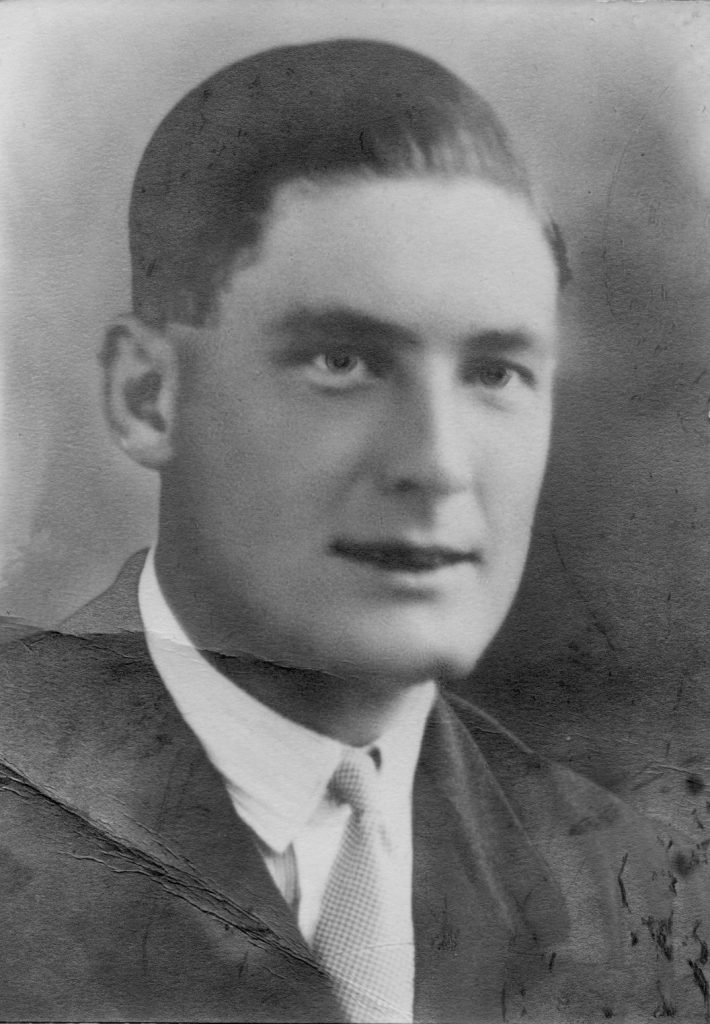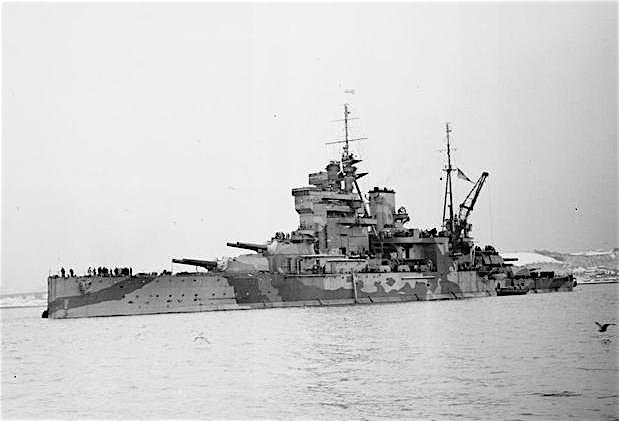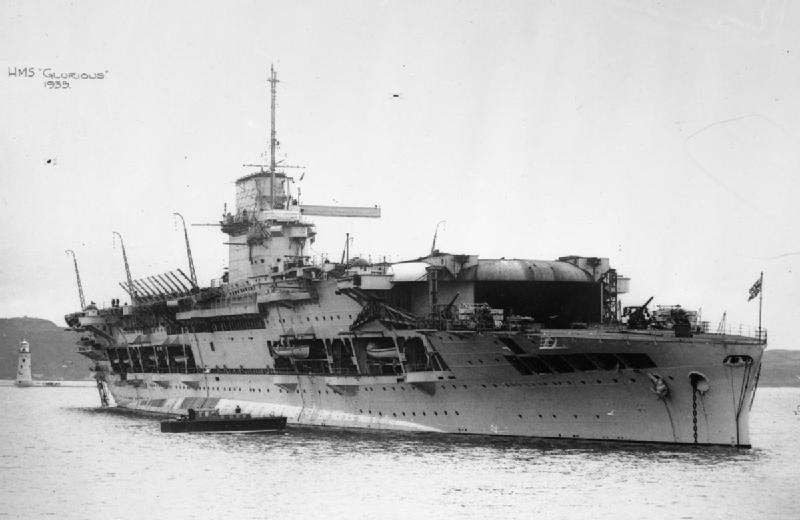
Richard William Wicks was born on the 3rd May 1905 at the family home, No 4 Springfield Road, Preston, Nr Brighton, Sussex. His mother was Ellen Louisa (Nee Offen) and his father, whom he was named after was Richard William Wicks who was a photographer.
At the time of the 1911 census, the family were residing at 2 Manwood Road, Grafton Park, Lewisham, London SE. Richard senior was listed as a photographer and also in the household was Ellen, the mother, Nellie (aged 9), Nora (aged 8), Richard junior now aged 5 and Minnie, aged 2.
Just a few months before Richards sixteenth birthday, he joined the Royal Navy on the 10th February 1921 as a Boy II Rating serving on HMS Ganges, the Royal Naval Training Establishment at Shotley, near Ipswich, where he stayed until 11th April 1922.
Following completion of shore training, Richard was transferred to HMS Queen Elizabeth, the dreadnought battleship that was the flagship of the Atlantic Fleet as a telegraphist.

After completing just over 2 years on the Queen Elizabeth, Richard was assigned to HMS Victory I at Portsmouth, another shore training establishment from 17th May 1924 to 30th June 1924. He was then re-assigned to HMS Champion from 1st July to 14th August 1924, after which he returned to Victory I until 1st July 1925.
On the 2nd July 1925, he was transferred to HMS Effingham, a Hawkins class heavy cruiser. He remained part of her company until 11th November 1926.

After his stint on Effingham, he returned to Victory I until the end of the month, due to being Commissioned wef 1st Dec 1926. As a trainee Officer, Richard undertook a variety of courses at HMS Victory, RN College Greenwich, HMS Vivid and HMS Defiance.
Following completion of his training in Dec 1927, he was assigned to HMS Emperor of India an Iron Duke Class battleships serving with the Atlantic Fleet. He remained part of this ships company until 29th September 1928.
On 12th July 1928, he had expressed an interest in transferring to the Fleet Air Arm and his Captain responded as follows: “C.O. states he is unable to grant W/K Best. at present owing to his small experience of upper deckwork. Has done very well and shows excellent promise. Capt W F Sells.“
Whilst serving on the Emperor, Richard married Hilda Bowditch on the 28th July 1928 at the Lewisham Registrar Office.
His service records show that he passed the RAF medical test on the 3rd Sept 1928 which was followed by him being attached to the RAF, under AFO 307/28, with effect 30th September 1928 and transferred to RAF Base Gosport on 13th May 1929.
Richard remained at Gosport until 5th Jan 1930, when he was assigned to HMS Furious which was a modified Courageous Class battlecruiser converted into an aircraft carrier. Her usual compliment of aircraft consisted of one flight of Fairey Flycatcher fighters, two of Blackburn Blackburn or Avro Bison spotters, one Fairey IIID spotter reconnaissance and two flights of Blackburn Dart torpedo bombers, each usually of six aircraft.
On the 16th Jan 1930, he passed his final deck landing and became qualified as a pilot.
On the 15th April 1930, he was assigned to HMS Glorious which was recommissioned on 24 February 1930 for service with the Mediterranean Fleet, but was attached to the Home Fleet from March to June 1930.

According to his service records, he was injured in air accident on on 15th Jan 1931, his injury was recorded as not serious but there is no mention of what the aircraft was.
The Flight Magazine of 4th Jan 1934 contained the list of RAF half yearly promotions and it confirmed that Richard William Wicks (Lieut RN) was promoted from Flying Officer to Flight Lieutenant. This is also confirmed in the Royal Navy List issued 1st Oct 1935 which shows his promotion wef 1st Jan 1934.

On the 2nd March 1937, The London Gazette contained the following entry “Lieut. Richard William WICKS, R.N., is re-attached to the Royal Air Force as a Flight Lieutenant with effect from 19th Feb.1937 and with seniority of 1st Jan. 1934.”
On the afternoon of Monday 15th March 1937 at 4:30PM, Melton Mowbray & District was enveloped in darkness. A severe blizzard and low, heavy clouds formed a complete blackout. Ten minutes later it had ceased snowing and the sky was bright again.
During those ten minutes, two RAF planes, passing over Melton, lost their bearings in the storm. They were flying low. A few seconds later, one of the machines was a complete wreck. The engine and cockpit were buried some eight feet in a field near Saxelbye, and the head of the pilot, who must have been killed instantly, could be seen protruding through the mass of debris. He was bare headed and around his neck was a red, white and blue scarf. The deceased pilot was Richard Wicks.
The aircraft were Blackburn Shark II’s from the RAF 11 Fighter Group at Gosport. The only piece of fabric that had survived the impact bore the identification number K43453. A wheel of the undercarriage was lying some thirty yards away while it was obvious from the stench of petrol that the tank had burst when the machine crashed.

Mr T Morris, of Manor Farm, Saxelbye, heard the machines and saw that one was in difficulties. Later he saw it nose dive into the field. He dashed to the scene and realising that it was hopeless to make any attempt to extricate the pilot, he telephoned Supt. Fotheridge, informing him of the tragedy. PC Neal was immediately sent out from Asfordby to investigate, being joined some fifteen minutes later by Supt Fotheridge and Sgt Jones.
The plane was a complete wreck, the engine, cockpit and pilot being embedded in a confused mass well below the surface of the ground. Although spades were brought, digging operations were too heavy a task to be worth even attempting. Until the arrival of suitable mechanism, all that could be done was to gaze on in despair.
The difficulties of recovering the pilot’s body were added to by darkness, thick fog, and the saturated condition of the land. Later in the evening, a breakdown gang from the Midland Garage was brought to the scene and under considerable difficulties driven to within a few yards of the wreckage. In the glare of its headlights and the feeble light shed by hurricane lamps brought from neighbouring farms, a twelve foot tripod, fitted with block and pulley was erected and with the assistance of some hundred villagers, attempts were begun to haul the wreckage out of the ground, to enable the pilots body to be released. For over four hours, this herculean task was carried out. Parts of the machine were raised with the pulley and lengthy tow ropes, manned by villagers who had flooded to the scene, pulled the wreckage clear.
When the heaviest of the debris had been removed, Sgt Jones was able to recover from the clothing of the pilot documents from which it was hoped means of identification would be obtainable. The pilots body was eventually released on the instruction of the Melton Coroner to the Melton War Memorial Hospital mortuary with identification “Lieut. R.W.Wicks RAF Base Southampton”.
At the subsequent inquest, Herbert Walter Brook, the NCO in charge of C Flt Training Squadron RAF Station detached at Southampton said that on the morning of 15th March 1937 he instructed the mechanics to do an inspection on the aircraft K4353, Lieut Wicks machine, and it was certified as airworthy. This was carried out and the engine ran satisfactorily on the ground test. “I myself certified the machine as airworthy after the inspection” he said. In reply to the coroner, he said that when the machine started at 10:10am he was satisfied that it was perfectly airworthy. It was not a brand new machine, but had been reconditioned in October. Corroborative evidence was given by William Shellick, an aircraftsman and one of the mechanics who examined the machine. Evidence was given that the machine was replenished with petrol and oil at Brough in company with 5 other machines. They left the aerodrome, one after another at about 4 o/clock.
Anthony John Trumble, Pilot Officer, Royal Air Force Base, stationed at Southampton, detached from Gosport, said that he left Brough in a similar machine about five minutes after Lieut. Wick’s machine had gone and joined it in formation over the Humber. “About 35 minutes after leaving Brough we ran into a thick snowstorm”. “I remember passing Newark but as we were flying in formation I was not doing navigation.” Trumble told the coroner that the snowstorm was intensely thick and that there were three of them in the first case, but they became separated. They were only flying together for a minute after entering the snowstorm- probably less. He went on to say “I did not know there had been an accident until the next morning”.
The pilots widow, Mrs Hilda B Wicks, of Timsbury Somerset, gave evidence of identifying the body. She told the inquest “Her husband was 31 years of age. He was a Flt Lt in the Fleet Air Arm of the RN. I last saw him on 11th February when he was home on leave”.

Richard Wicks was given a funeral with full military honours and was buried at Thorpe Road Cemetery, Melton Mowbray. The coffin was draped in a Union Jack and was carried to the cemetery on a Royal Air Force goods trailer. The standard bearer party consisted of six RAF Sergeants from Grantham, and the service was conducted by Canon P. Robson, Vicar of Melton Mowbray.
The funeral was attended by the widow Mrs Hilda B Wicks, Miss M Wicks (sister), and Mr & Mrs H P Morris. The Air Officer Commanding-in-Chief, Coastal Command, was represented by Lieut.V.C. Grenfell, R.N. Others present were Lieut Commander Shattock, R.N. (Gosport), Group Capt Iron and Flight Lieut. Langston of Grantham RAF Depot.
